Psychological Issues: Understanding Domestic Violence and Its Causes
VerifiedAdded on 2023/06/12
|9
|2391
|306
AI Summary
This article discusses the issue of domestic violence, its causes, and the psychological concepts related to it. It also provides a summary of related research and suggests ways to prevent and deal with domestic violence.
Contribute Materials
Your contribution can guide someone’s learning journey. Share your
documents today.
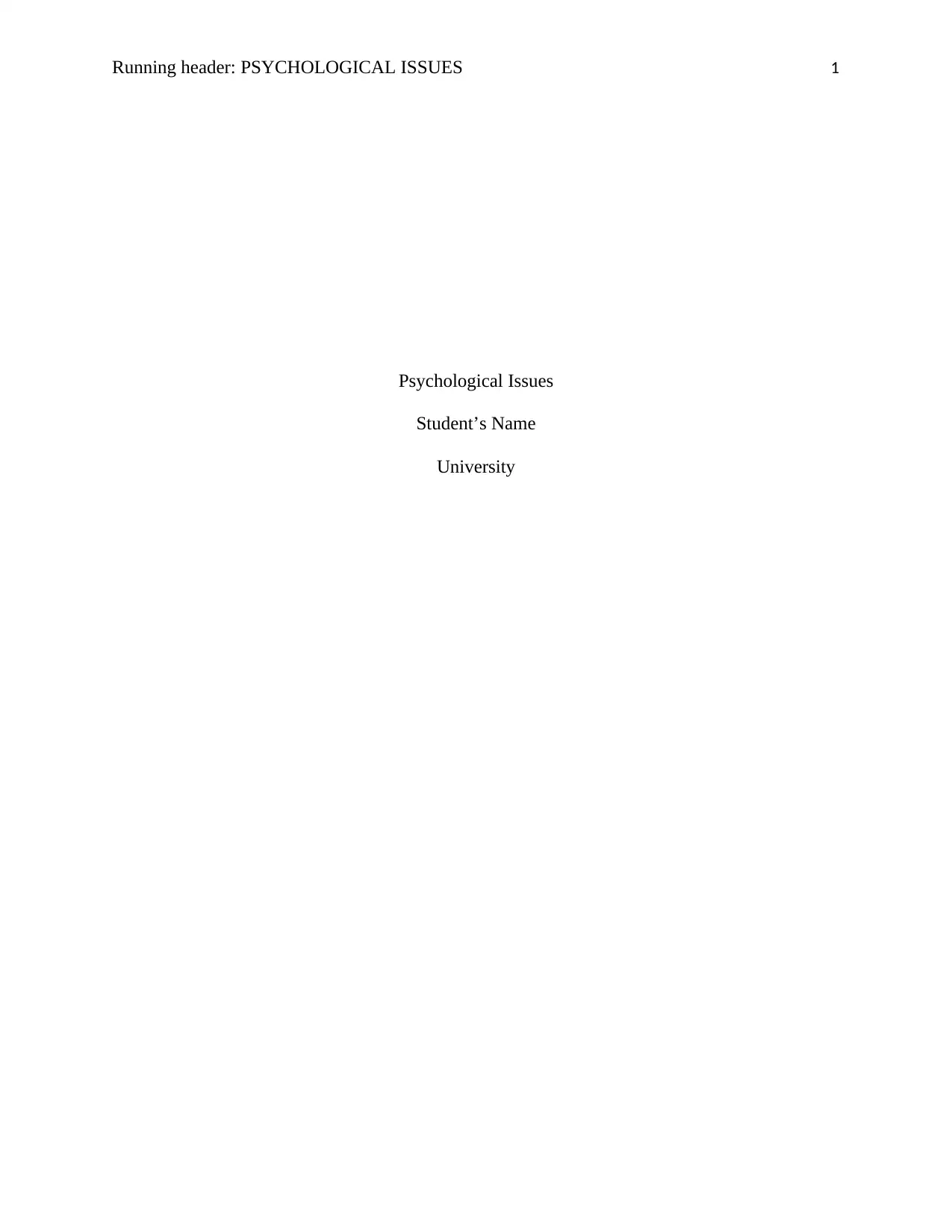
Running header: PSYCHOLOGICAL ISSUES 1
Psychological Issues
Student’s Name
University
Psychological Issues
Student’s Name
University
Secure Best Marks with AI Grader
Need help grading? Try our AI Grader for instant feedback on your assignments.
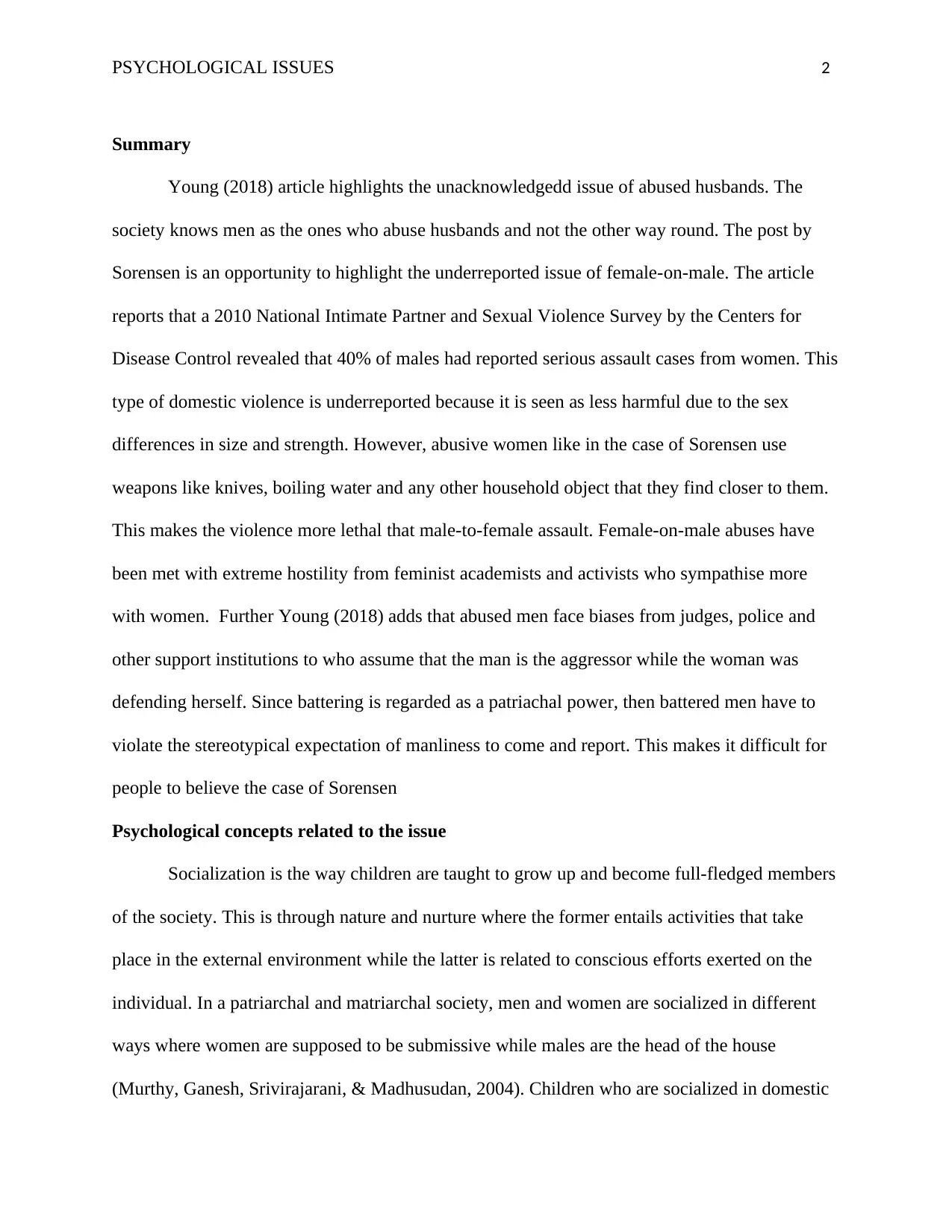
PSYCHOLOGICAL ISSUES 2
Summary
Young (2018) article highlights the unacknowledgedd issue of abused husbands. The
society knows men as the ones who abuse husbands and not the other way round. The post by
Sorensen is an opportunity to highlight the underreported issue of female-on-male. The article
reports that a 2010 National Intimate Partner and Sexual Violence Survey by the Centers for
Disease Control revealed that 40% of males had reported serious assault cases from women. This
type of domestic violence is underreported because it is seen as less harmful due to the sex
differences in size and strength. However, abusive women like in the case of Sorensen use
weapons like knives, boiling water and any other household object that they find closer to them.
This makes the violence more lethal that male-to-female assault. Female-on-male abuses have
been met with extreme hostility from feminist academists and activists who sympathise more
with women. Further Young (2018) adds that abused men face biases from judges, police and
other support institutions to who assume that the man is the aggressor while the woman was
defending herself. Since battering is regarded as a patriachal power, then battered men have to
violate the stereotypical expectation of manliness to come and report. This makes it difficult for
people to believe the case of Sorensen
Psychological concepts related to the issue
Socialization is the way children are taught to grow up and become full-fledged members
of the society. This is through nature and nurture where the former entails activities that take
place in the external environment while the latter is related to conscious efforts exerted on the
individual. In a patriarchal and matriarchal society, men and women are socialized in different
ways where women are supposed to be submissive while males are the head of the house
(Murthy, Ganesh, Srivirajarani, & Madhusudan, 2004). Children who are socialized in domestic
Summary
Young (2018) article highlights the unacknowledgedd issue of abused husbands. The
society knows men as the ones who abuse husbands and not the other way round. The post by
Sorensen is an opportunity to highlight the underreported issue of female-on-male. The article
reports that a 2010 National Intimate Partner and Sexual Violence Survey by the Centers for
Disease Control revealed that 40% of males had reported serious assault cases from women. This
type of domestic violence is underreported because it is seen as less harmful due to the sex
differences in size and strength. However, abusive women like in the case of Sorensen use
weapons like knives, boiling water and any other household object that they find closer to them.
This makes the violence more lethal that male-to-female assault. Female-on-male abuses have
been met with extreme hostility from feminist academists and activists who sympathise more
with women. Further Young (2018) adds that abused men face biases from judges, police and
other support institutions to who assume that the man is the aggressor while the woman was
defending herself. Since battering is regarded as a patriachal power, then battered men have to
violate the stereotypical expectation of manliness to come and report. This makes it difficult for
people to believe the case of Sorensen
Psychological concepts related to the issue
Socialization is the way children are taught to grow up and become full-fledged members
of the society. This is through nature and nurture where the former entails activities that take
place in the external environment while the latter is related to conscious efforts exerted on the
individual. In a patriarchal and matriarchal society, men and women are socialized in different
ways where women are supposed to be submissive while males are the head of the house
(Murthy, Ganesh, Srivirajarani, & Madhusudan, 2004). Children who are socialized in domestic
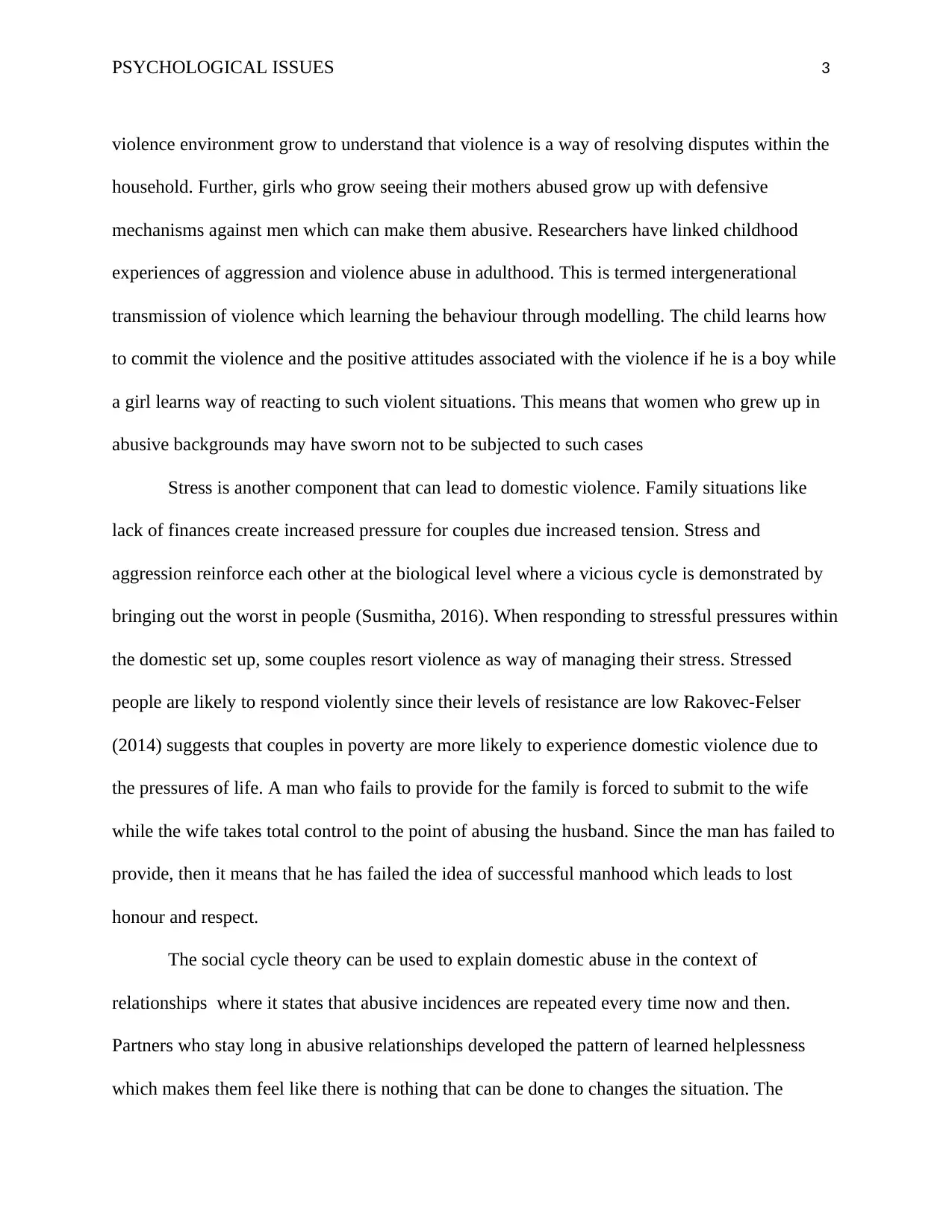
PSYCHOLOGICAL ISSUES 3
violence environment grow to understand that violence is a way of resolving disputes within the
household. Further, girls who grow seeing their mothers abused grow up with defensive
mechanisms against men which can make them abusive. Researchers have linked childhood
experiences of aggression and violence abuse in adulthood. This is termed intergenerational
transmission of violence which learning the behaviour through modelling. The child learns how
to commit the violence and the positive attitudes associated with the violence if he is a boy while
a girl learns way of reacting to such violent situations. This means that women who grew up in
abusive backgrounds may have sworn not to be subjected to such cases
Stress is another component that can lead to domestic violence. Family situations like
lack of finances create increased pressure for couples due increased tension. Stress and
aggression reinforce each other at the biological level where a vicious cycle is demonstrated by
bringing out the worst in people (Susmitha, 2016). When responding to stressful pressures within
the domestic set up, some couples resort violence as way of managing their stress. Stressed
people are likely to respond violently since their levels of resistance are low Rakovec-Felser
(2014) suggests that couples in poverty are more likely to experience domestic violence due to
the pressures of life. A man who fails to provide for the family is forced to submit to the wife
while the wife takes total control to the point of abusing the husband. Since the man has failed to
provide, then it means that he has failed the idea of successful manhood which leads to lost
honour and respect.
The social cycle theory can be used to explain domestic abuse in the context of
relationships where it states that abusive incidences are repeated every time now and then.
Partners who stay long in abusive relationships developed the pattern of learned helplessness
which makes them feel like there is nothing that can be done to changes the situation. The
violence environment grow to understand that violence is a way of resolving disputes within the
household. Further, girls who grow seeing their mothers abused grow up with defensive
mechanisms against men which can make them abusive. Researchers have linked childhood
experiences of aggression and violence abuse in adulthood. This is termed intergenerational
transmission of violence which learning the behaviour through modelling. The child learns how
to commit the violence and the positive attitudes associated with the violence if he is a boy while
a girl learns way of reacting to such violent situations. This means that women who grew up in
abusive backgrounds may have sworn not to be subjected to such cases
Stress is another component that can lead to domestic violence. Family situations like
lack of finances create increased pressure for couples due increased tension. Stress and
aggression reinforce each other at the biological level where a vicious cycle is demonstrated by
bringing out the worst in people (Susmitha, 2016). When responding to stressful pressures within
the domestic set up, some couples resort violence as way of managing their stress. Stressed
people are likely to respond violently since their levels of resistance are low Rakovec-Felser
(2014) suggests that couples in poverty are more likely to experience domestic violence due to
the pressures of life. A man who fails to provide for the family is forced to submit to the wife
while the wife takes total control to the point of abusing the husband. Since the man has failed to
provide, then it means that he has failed the idea of successful manhood which leads to lost
honour and respect.
The social cycle theory can be used to explain domestic abuse in the context of
relationships where it states that abusive incidences are repeated every time now and then.
Partners who stay long in abusive relationships developed the pattern of learned helplessness
which makes them feel like there is nothing that can be done to changes the situation. The
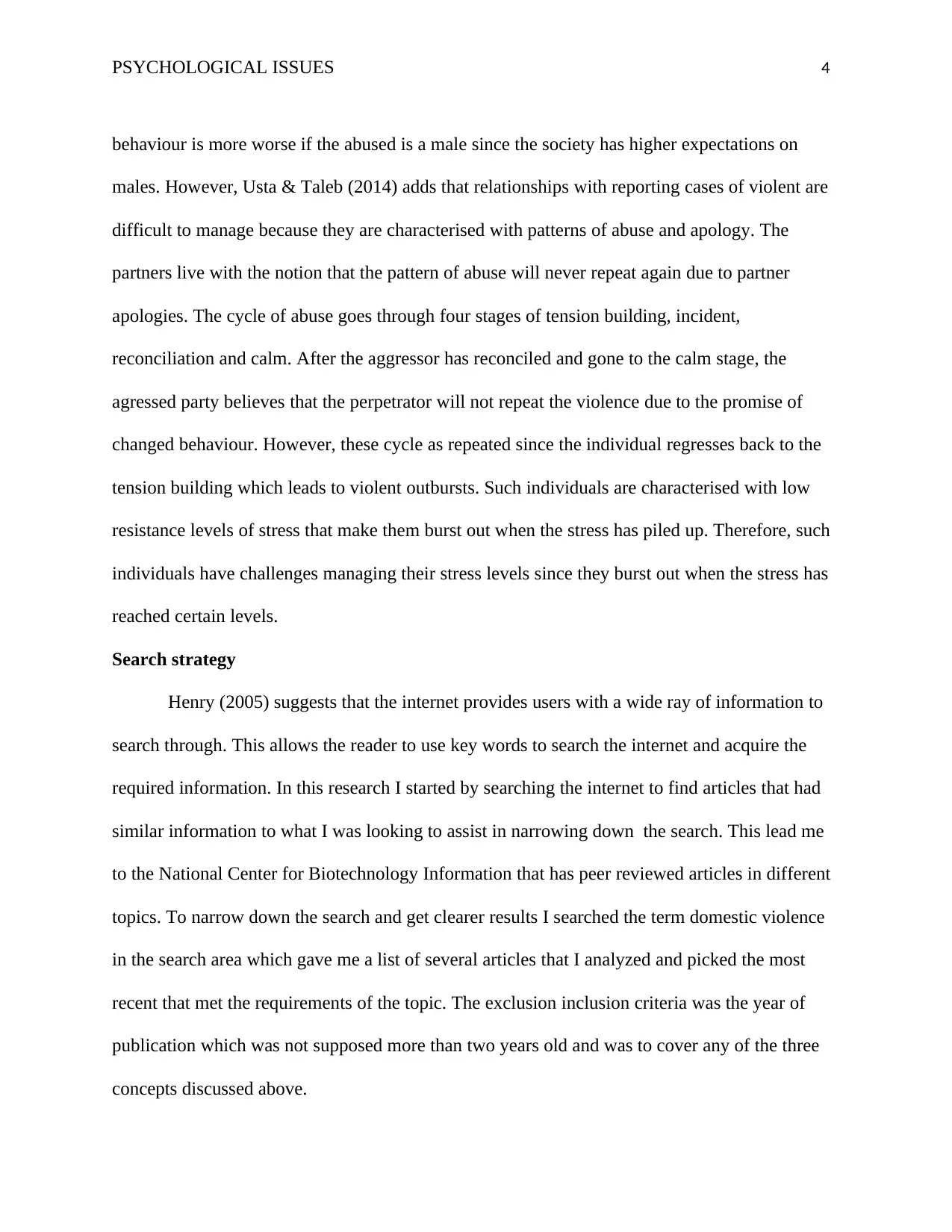
PSYCHOLOGICAL ISSUES 4
behaviour is more worse if the abused is a male since the society has higher expectations on
males. However, Usta & Taleb (2014) adds that relationships with reporting cases of violent are
difficult to manage because they are characterised with patterns of abuse and apology. The
partners live with the notion that the pattern of abuse will never repeat again due to partner
apologies. The cycle of abuse goes through four stages of tension building, incident,
reconciliation and calm. After the aggressor has reconciled and gone to the calm stage, the
agressed party believes that the perpetrator will not repeat the violence due to the promise of
changed behaviour. However, these cycle as repeated since the individual regresses back to the
tension building which leads to violent outbursts. Such individuals are characterised with low
resistance levels of stress that make them burst out when the stress has piled up. Therefore, such
individuals have challenges managing their stress levels since they burst out when the stress has
reached certain levels.
Search strategy
Henry (2005) suggests that the internet provides users with a wide ray of information to
search through. This allows the reader to use key words to search the internet and acquire the
required information. In this research I started by searching the internet to find articles that had
similar information to what I was looking to assist in narrowing down the search. This lead me
to the National Center for Biotechnology Information that has peer reviewed articles in different
topics. To narrow down the search and get clearer results I searched the term domestic violence
in the search area which gave me a list of several articles that I analyzed and picked the most
recent that met the requirements of the topic. The exclusion inclusion criteria was the year of
publication which was not supposed more than two years old and was to cover any of the three
concepts discussed above.
behaviour is more worse if the abused is a male since the society has higher expectations on
males. However, Usta & Taleb (2014) adds that relationships with reporting cases of violent are
difficult to manage because they are characterised with patterns of abuse and apology. The
partners live with the notion that the pattern of abuse will never repeat again due to partner
apologies. The cycle of abuse goes through four stages of tension building, incident,
reconciliation and calm. After the aggressor has reconciled and gone to the calm stage, the
agressed party believes that the perpetrator will not repeat the violence due to the promise of
changed behaviour. However, these cycle as repeated since the individual regresses back to the
tension building which leads to violent outbursts. Such individuals are characterised with low
resistance levels of stress that make them burst out when the stress has piled up. Therefore, such
individuals have challenges managing their stress levels since they burst out when the stress has
reached certain levels.
Search strategy
Henry (2005) suggests that the internet provides users with a wide ray of information to
search through. This allows the reader to use key words to search the internet and acquire the
required information. In this research I started by searching the internet to find articles that had
similar information to what I was looking to assist in narrowing down the search. This lead me
to the National Center for Biotechnology Information that has peer reviewed articles in different
topics. To narrow down the search and get clearer results I searched the term domestic violence
in the search area which gave me a list of several articles that I analyzed and picked the most
recent that met the requirements of the topic. The exclusion inclusion criteria was the year of
publication which was not supposed more than two years old and was to cover any of the three
concepts discussed above.
Secure Best Marks with AI Grader
Need help grading? Try our AI Grader for instant feedback on your assignments.
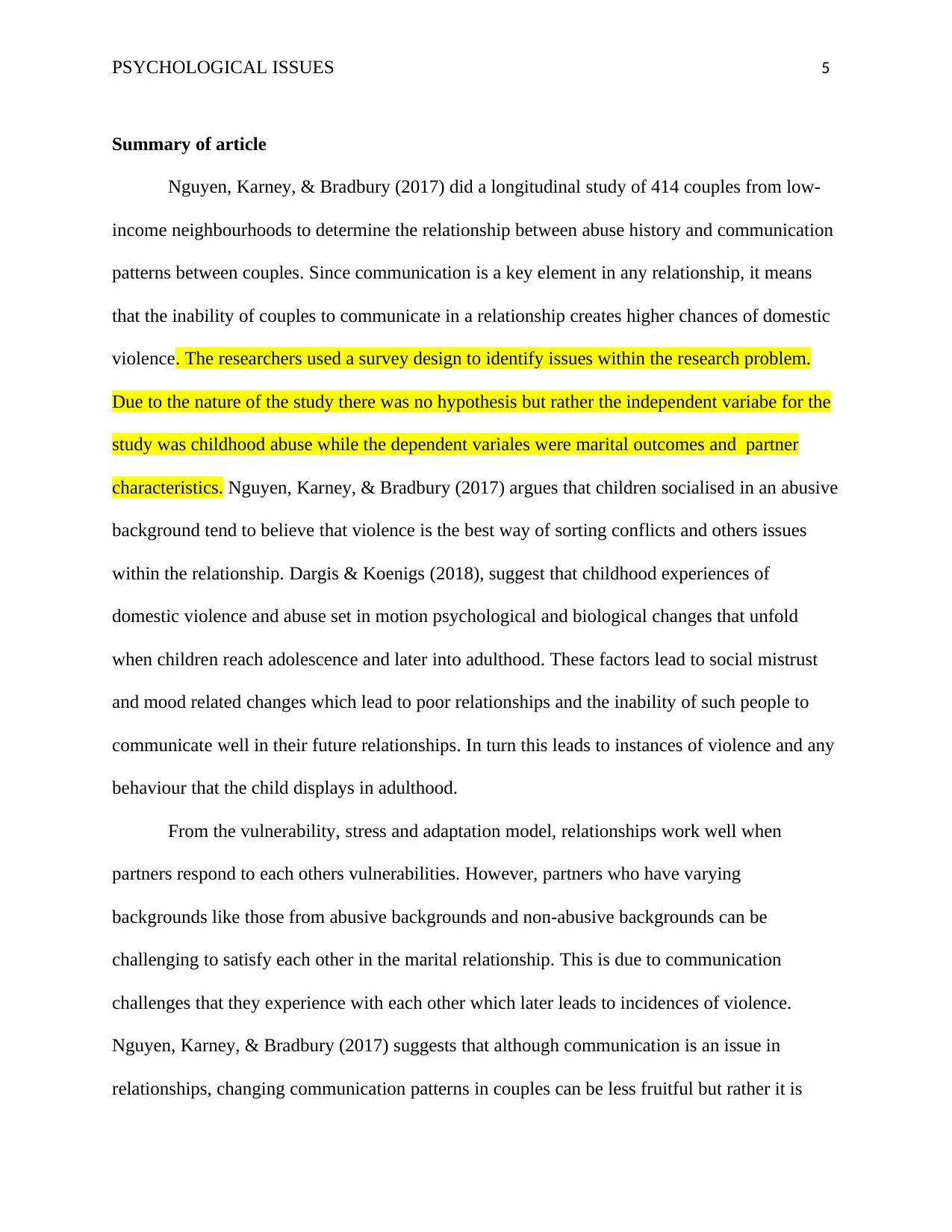
PSYCHOLOGICAL ISSUES 5
Summary of article
Nguyen, Karney, & Bradbury (2017) did a longitudinal study of 414 couples from low-
income neighbourhoods to determine the relationship between abuse history and communication
patterns between couples. Since communication is a key element in any relationship, it means
that the inability of couples to communicate in a relationship creates higher chances of domestic
violence. The researchers used a survey design to identify issues within the research problem.
Due to the nature of the study there was no hypothesis but rather the independent variabe for the
study was childhood abuse while the dependent variales were marital outcomes and partner
characteristics. Nguyen, Karney, & Bradbury (2017) argues that children socialised in an abusive
background tend to believe that violence is the best way of sorting conflicts and others issues
within the relationship. Dargis & Koenigs (2018), suggest that childhood experiences of
domestic violence and abuse set in motion psychological and biological changes that unfold
when children reach adolescence and later into adulthood. These factors lead to social mistrust
and mood related changes which lead to poor relationships and the inability of such people to
communicate well in their future relationships. In turn this leads to instances of violence and any
behaviour that the child displays in adulthood.
From the vulnerability, stress and adaptation model, relationships work well when
partners respond to each others vulnerabilities. However, partners who have varying
backgrounds like those from abusive backgrounds and non-abusive backgrounds can be
challenging to satisfy each other in the marital relationship. This is due to communication
challenges that they experience with each other which later leads to incidences of violence.
Nguyen, Karney, & Bradbury (2017) suggests that although communication is an issue in
relationships, changing communication patterns in couples can be less fruitful but rather it is
Summary of article
Nguyen, Karney, & Bradbury (2017) did a longitudinal study of 414 couples from low-
income neighbourhoods to determine the relationship between abuse history and communication
patterns between couples. Since communication is a key element in any relationship, it means
that the inability of couples to communicate in a relationship creates higher chances of domestic
violence. The researchers used a survey design to identify issues within the research problem.
Due to the nature of the study there was no hypothesis but rather the independent variabe for the
study was childhood abuse while the dependent variales were marital outcomes and partner
characteristics. Nguyen, Karney, & Bradbury (2017) argues that children socialised in an abusive
background tend to believe that violence is the best way of sorting conflicts and others issues
within the relationship. Dargis & Koenigs (2018), suggest that childhood experiences of
domestic violence and abuse set in motion psychological and biological changes that unfold
when children reach adolescence and later into adulthood. These factors lead to social mistrust
and mood related changes which lead to poor relationships and the inability of such people to
communicate well in their future relationships. In turn this leads to instances of violence and any
behaviour that the child displays in adulthood.
From the vulnerability, stress and adaptation model, relationships work well when
partners respond to each others vulnerabilities. However, partners who have varying
backgrounds like those from abusive backgrounds and non-abusive backgrounds can be
challenging to satisfy each other in the marital relationship. This is due to communication
challenges that they experience with each other which later leads to incidences of violence.
Nguyen, Karney, & Bradbury (2017) suggests that although communication is an issue in
relationships, changing communication patterns in couples can be less fruitful but rather it is
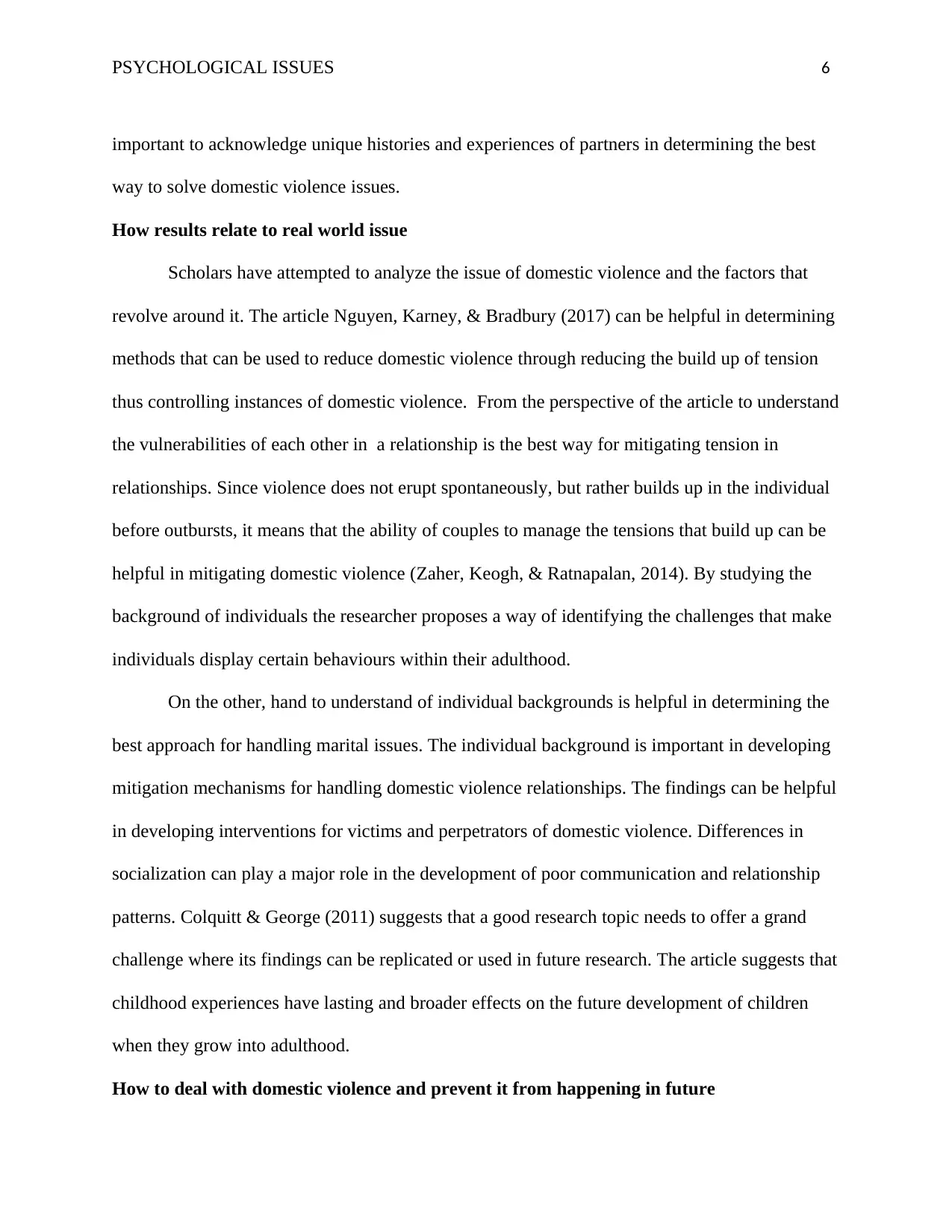
PSYCHOLOGICAL ISSUES 6
important to acknowledge unique histories and experiences of partners in determining the best
way to solve domestic violence issues.
How results relate to real world issue
Scholars have attempted to analyze the issue of domestic violence and the factors that
revolve around it. The article Nguyen, Karney, & Bradbury (2017) can be helpful in determining
methods that can be used to reduce domestic violence through reducing the build up of tension
thus controlling instances of domestic violence. From the perspective of the article to understand
the vulnerabilities of each other in a relationship is the best way for mitigating tension in
relationships. Since violence does not erupt spontaneously, but rather builds up in the individual
before outbursts, it means that the ability of couples to manage the tensions that build up can be
helpful in mitigating domestic violence (Zaher, Keogh, & Ratnapalan, 2014). By studying the
background of individuals the researcher proposes a way of identifying the challenges that make
individuals display certain behaviours within their adulthood.
On the other, hand to understand of individual backgrounds is helpful in determining the
best approach for handling marital issues. The individual background is important in developing
mitigation mechanisms for handling domestic violence relationships. The findings can be helpful
in developing interventions for victims and perpetrators of domestic violence. Differences in
socialization can play a major role in the development of poor communication and relationship
patterns. Colquitt & George (2011) suggests that a good research topic needs to offer a grand
challenge where its findings can be replicated or used in future research. The article suggests that
childhood experiences have lasting and broader effects on the future development of children
when they grow into adulthood.
How to deal with domestic violence and prevent it from happening in future
important to acknowledge unique histories and experiences of partners in determining the best
way to solve domestic violence issues.
How results relate to real world issue
Scholars have attempted to analyze the issue of domestic violence and the factors that
revolve around it. The article Nguyen, Karney, & Bradbury (2017) can be helpful in determining
methods that can be used to reduce domestic violence through reducing the build up of tension
thus controlling instances of domestic violence. From the perspective of the article to understand
the vulnerabilities of each other in a relationship is the best way for mitigating tension in
relationships. Since violence does not erupt spontaneously, but rather builds up in the individual
before outbursts, it means that the ability of couples to manage the tensions that build up can be
helpful in mitigating domestic violence (Zaher, Keogh, & Ratnapalan, 2014). By studying the
background of individuals the researcher proposes a way of identifying the challenges that make
individuals display certain behaviours within their adulthood.
On the other, hand to understand of individual backgrounds is helpful in determining the
best approach for handling marital issues. The individual background is important in developing
mitigation mechanisms for handling domestic violence relationships. The findings can be helpful
in developing interventions for victims and perpetrators of domestic violence. Differences in
socialization can play a major role in the development of poor communication and relationship
patterns. Colquitt & George (2011) suggests that a good research topic needs to offer a grand
challenge where its findings can be replicated or used in future research. The article suggests that
childhood experiences have lasting and broader effects on the future development of children
when they grow into adulthood.
How to deal with domestic violence and prevent it from happening in future
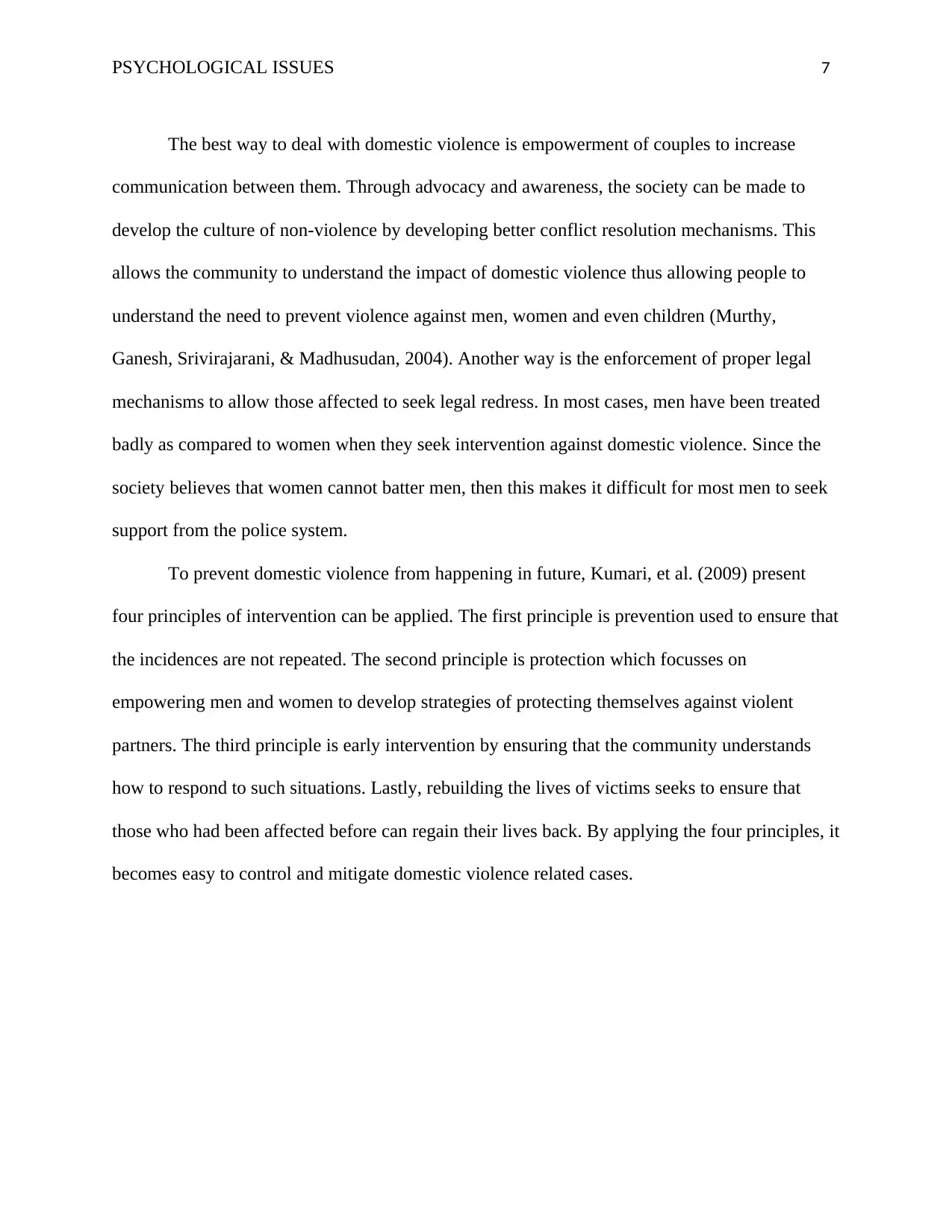
PSYCHOLOGICAL ISSUES 7
The best way to deal with domestic violence is empowerment of couples to increase
communication between them. Through advocacy and awareness, the society can be made to
develop the culture of non-violence by developing better conflict resolution mechanisms. This
allows the community to understand the impact of domestic violence thus allowing people to
understand the need to prevent violence against men, women and even children (Murthy,
Ganesh, Srivirajarani, & Madhusudan, 2004). Another way is the enforcement of proper legal
mechanisms to allow those affected to seek legal redress. In most cases, men have been treated
badly as compared to women when they seek intervention against domestic violence. Since the
society believes that women cannot batter men, then this makes it difficult for most men to seek
support from the police system.
To prevent domestic violence from happening in future, Kumari, et al. (2009) present
four principles of intervention can be applied. The first principle is prevention used to ensure that
the incidences are not repeated. The second principle is protection which focusses on
empowering men and women to develop strategies of protecting themselves against violent
partners. The third principle is early intervention by ensuring that the community understands
how to respond to such situations. Lastly, rebuilding the lives of victims seeks to ensure that
those who had been affected before can regain their lives back. By applying the four principles, it
becomes easy to control and mitigate domestic violence related cases.
The best way to deal with domestic violence is empowerment of couples to increase
communication between them. Through advocacy and awareness, the society can be made to
develop the culture of non-violence by developing better conflict resolution mechanisms. This
allows the community to understand the impact of domestic violence thus allowing people to
understand the need to prevent violence against men, women and even children (Murthy,
Ganesh, Srivirajarani, & Madhusudan, 2004). Another way is the enforcement of proper legal
mechanisms to allow those affected to seek legal redress. In most cases, men have been treated
badly as compared to women when they seek intervention against domestic violence. Since the
society believes that women cannot batter men, then this makes it difficult for most men to seek
support from the police system.
To prevent domestic violence from happening in future, Kumari, et al. (2009) present
four principles of intervention can be applied. The first principle is prevention used to ensure that
the incidences are not repeated. The second principle is protection which focusses on
empowering men and women to develop strategies of protecting themselves against violent
partners. The third principle is early intervention by ensuring that the community understands
how to respond to such situations. Lastly, rebuilding the lives of victims seeks to ensure that
those who had been affected before can regain their lives back. By applying the four principles, it
becomes easy to control and mitigate domestic violence related cases.
Paraphrase This Document
Need a fresh take? Get an instant paraphrase of this document with our AI Paraphraser
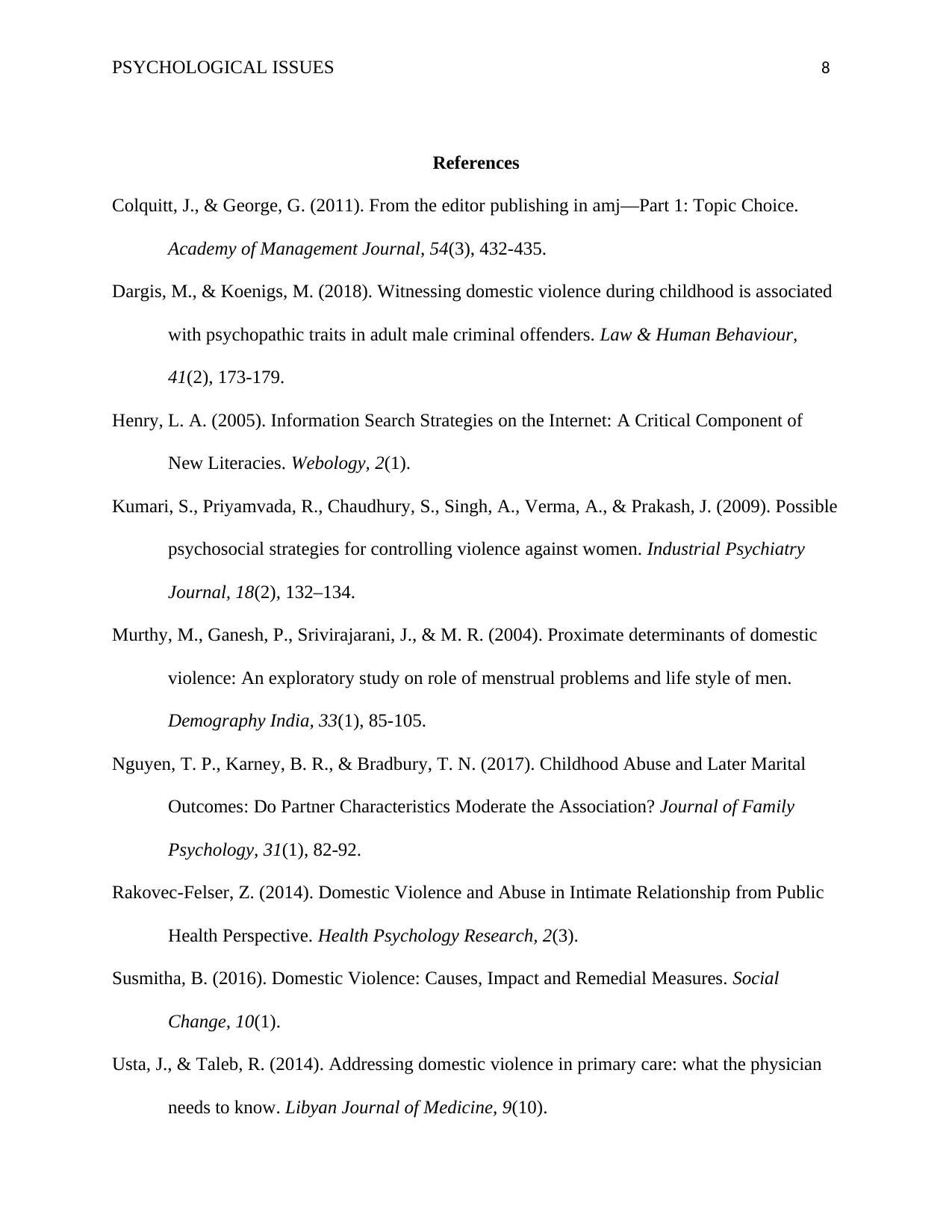
PSYCHOLOGICAL ISSUES 8
References
Colquitt, J., & George, G. (2011). From the editor publishing in amj—Part 1: Topic Choice.
Academy of Management Journal, 54(3), 432-435.
Dargis, M., & Koenigs, M. (2018). Witnessing domestic violence during childhood is associated
with psychopathic traits in adult male criminal offenders. Law & Human Behaviour,
41(2), 173-179.
Henry, L. A. (2005). Information Search Strategies on the Internet: A Critical Component of
New Literacies. Webology, 2(1).
Kumari, S., Priyamvada, R., Chaudhury, S., Singh, A., Verma, A., & Prakash, J. (2009). Possible
psychosocial strategies for controlling violence against women. Industrial Psychiatry
Journal, 18(2), 132–134.
Murthy, M., Ganesh, P., Srivirajarani, J., & M. R. (2004). Proximate determinants of domestic
violence: An exploratory study on role of menstrual problems and life style of men.
Demography India, 33(1), 85-105.
Nguyen, T. P., Karney, B. R., & Bradbury, T. N. (2017). Childhood Abuse and Later Marital
Outcomes: Do Partner Characteristics Moderate the Association? Journal of Family
Psychology, 31(1), 82-92.
Rakovec-Felser, Z. (2014). Domestic Violence and Abuse in Intimate Relationship from Public
Health Perspective. Health Psychology Research, 2(3).
Susmitha, B. (2016). Domestic Violence: Causes, Impact and Remedial Measures. Social
Change, 10(1).
Usta, J., & Taleb, R. (2014). Addressing domestic violence in primary care: what the physician
needs to know. Libyan Journal of Medicine, 9(10).
References
Colquitt, J., & George, G. (2011). From the editor publishing in amj—Part 1: Topic Choice.
Academy of Management Journal, 54(3), 432-435.
Dargis, M., & Koenigs, M. (2018). Witnessing domestic violence during childhood is associated
with psychopathic traits in adult male criminal offenders. Law & Human Behaviour,
41(2), 173-179.
Henry, L. A. (2005). Information Search Strategies on the Internet: A Critical Component of
New Literacies. Webology, 2(1).
Kumari, S., Priyamvada, R., Chaudhury, S., Singh, A., Verma, A., & Prakash, J. (2009). Possible
psychosocial strategies for controlling violence against women. Industrial Psychiatry
Journal, 18(2), 132–134.
Murthy, M., Ganesh, P., Srivirajarani, J., & M. R. (2004). Proximate determinants of domestic
violence: An exploratory study on role of menstrual problems and life style of men.
Demography India, 33(1), 85-105.
Nguyen, T. P., Karney, B. R., & Bradbury, T. N. (2017). Childhood Abuse and Later Marital
Outcomes: Do Partner Characteristics Moderate the Association? Journal of Family
Psychology, 31(1), 82-92.
Rakovec-Felser, Z. (2014). Domestic Violence and Abuse in Intimate Relationship from Public
Health Perspective. Health Psychology Research, 2(3).
Susmitha, B. (2016). Domestic Violence: Causes, Impact and Remedial Measures. Social
Change, 10(1).
Usta, J., & Taleb, R. (2014). Addressing domestic violence in primary care: what the physician
needs to know. Libyan Journal of Medicine, 9(10).

PSYCHOLOGICAL ISSUES 9
Young, C. (2018, February 22). When wives beat their husbands, no one wants to believe it. Los
Angeles Times.
Zaher, E., Keogh, K., & Ratnapalan, S. (2014). Effect of domestic violence training. Canadian
Family Physician, 60(7), 618-624.
Young, C. (2018, February 22). When wives beat their husbands, no one wants to believe it. Los
Angeles Times.
Zaher, E., Keogh, K., & Ratnapalan, S. (2014). Effect of domestic violence training. Canadian
Family Physician, 60(7), 618-624.
1 out of 9
Related Documents
Your All-in-One AI-Powered Toolkit for Academic Success.
+13062052269
info@desklib.com
Available 24*7 on WhatsApp / Email
![[object Object]](/_next/static/media/star-bottom.7253800d.svg)
Unlock your academic potential
© 2024 | Zucol Services PVT LTD | All rights reserved.




